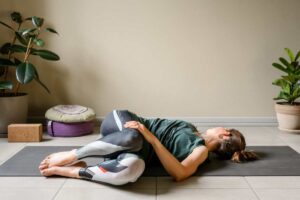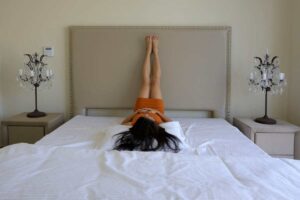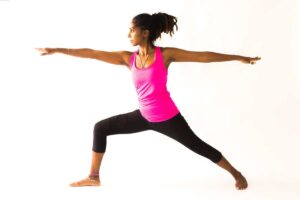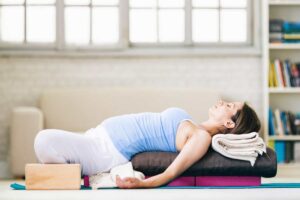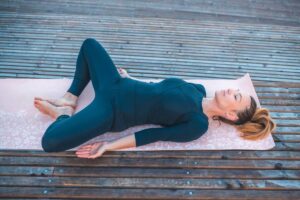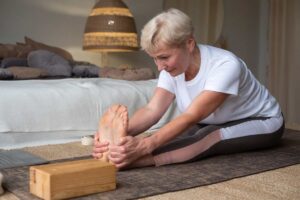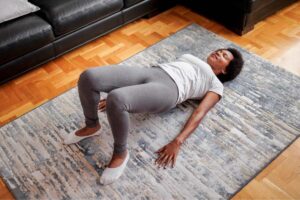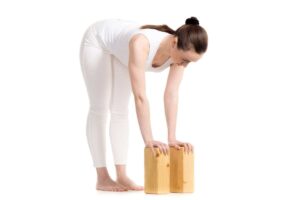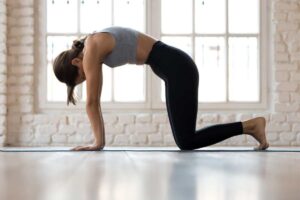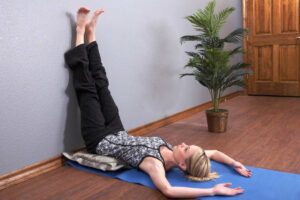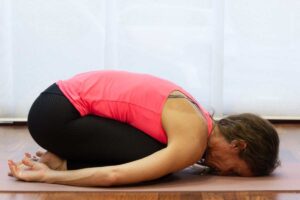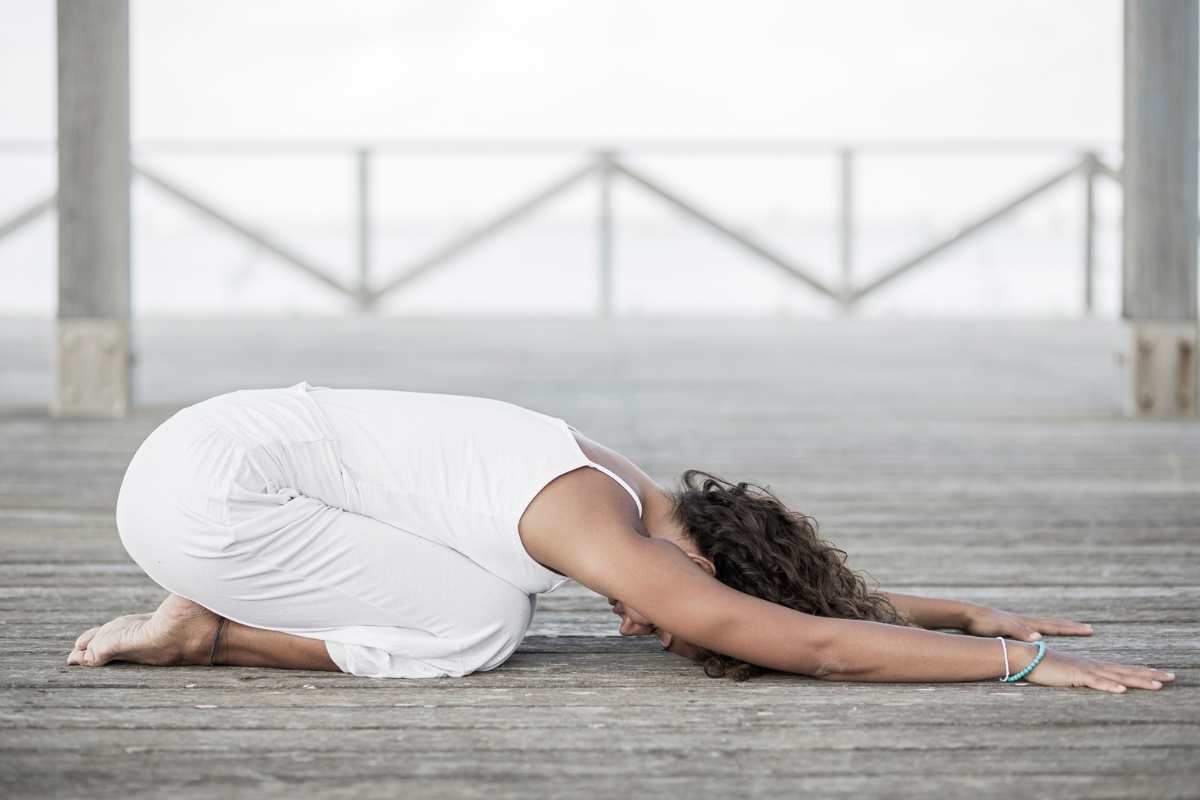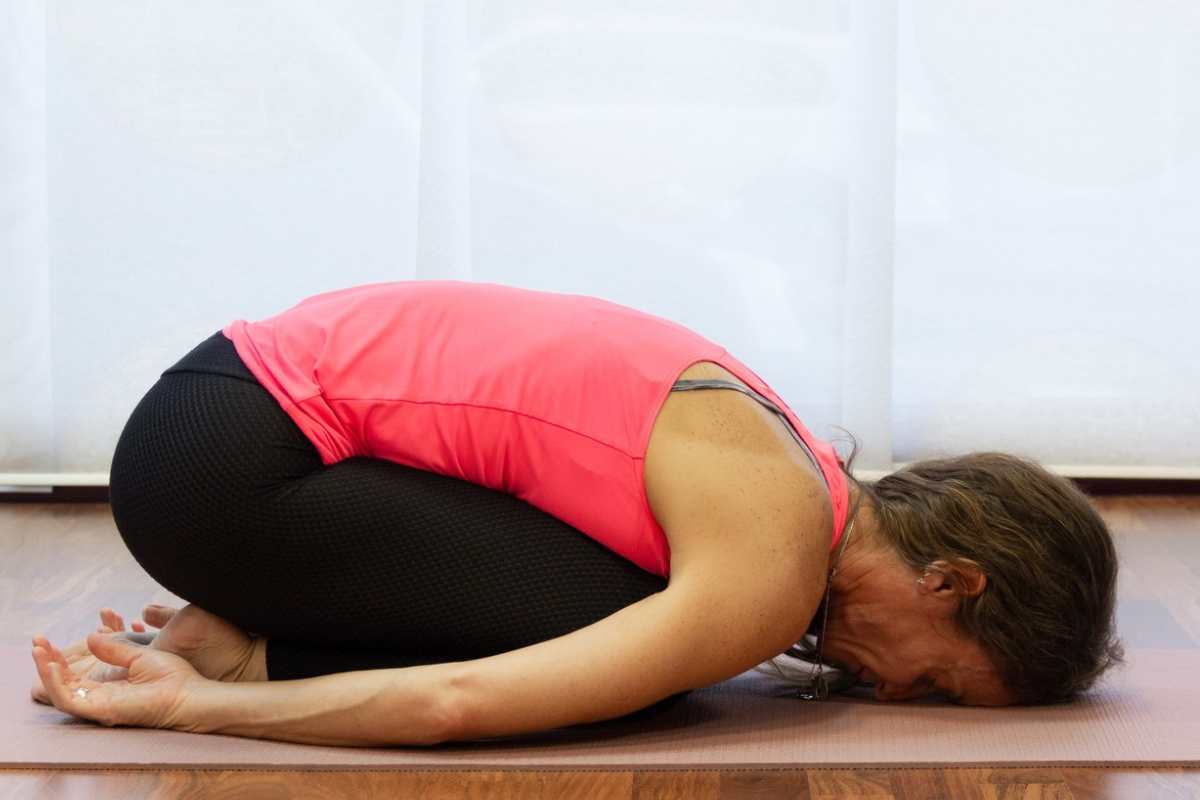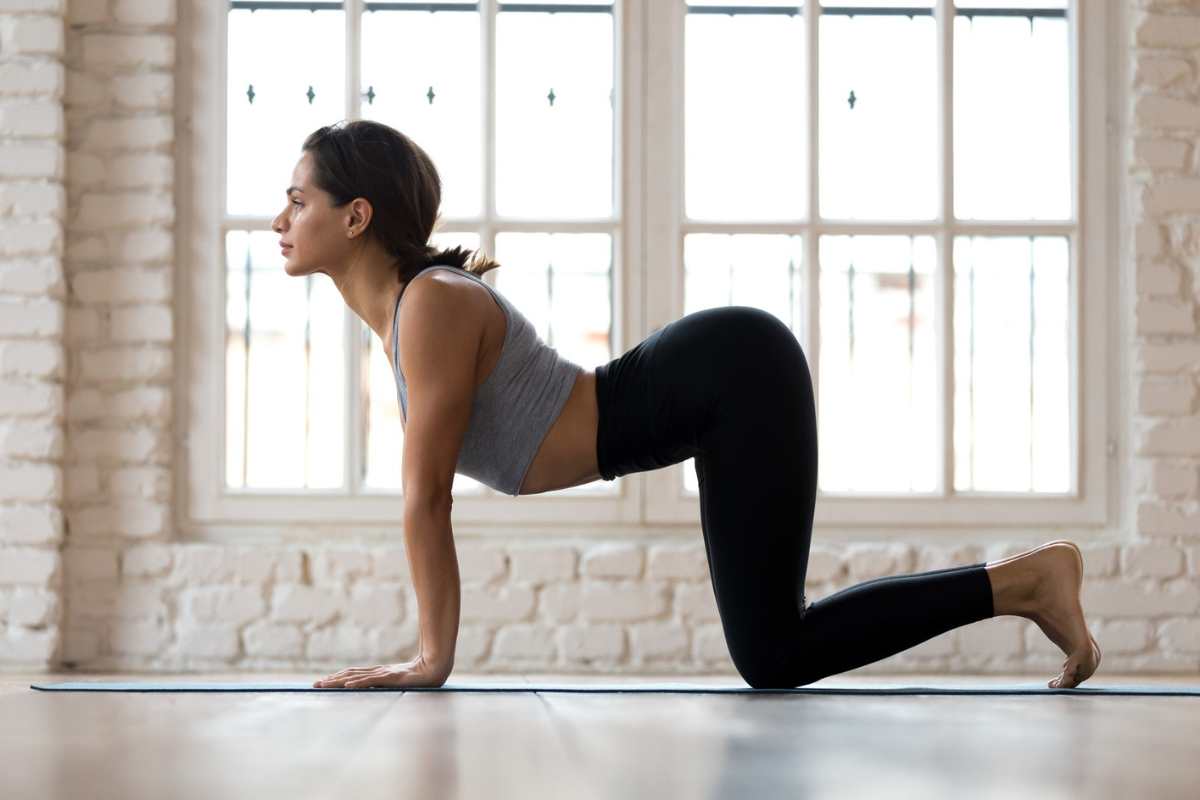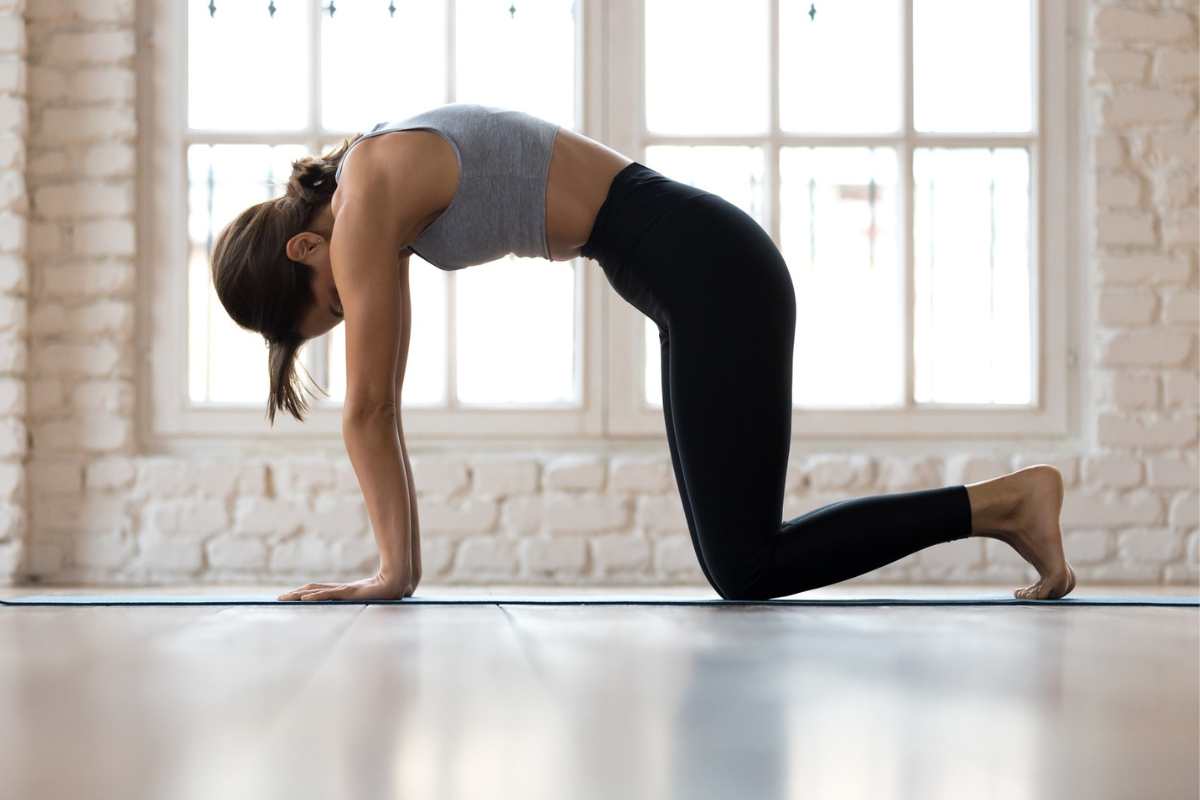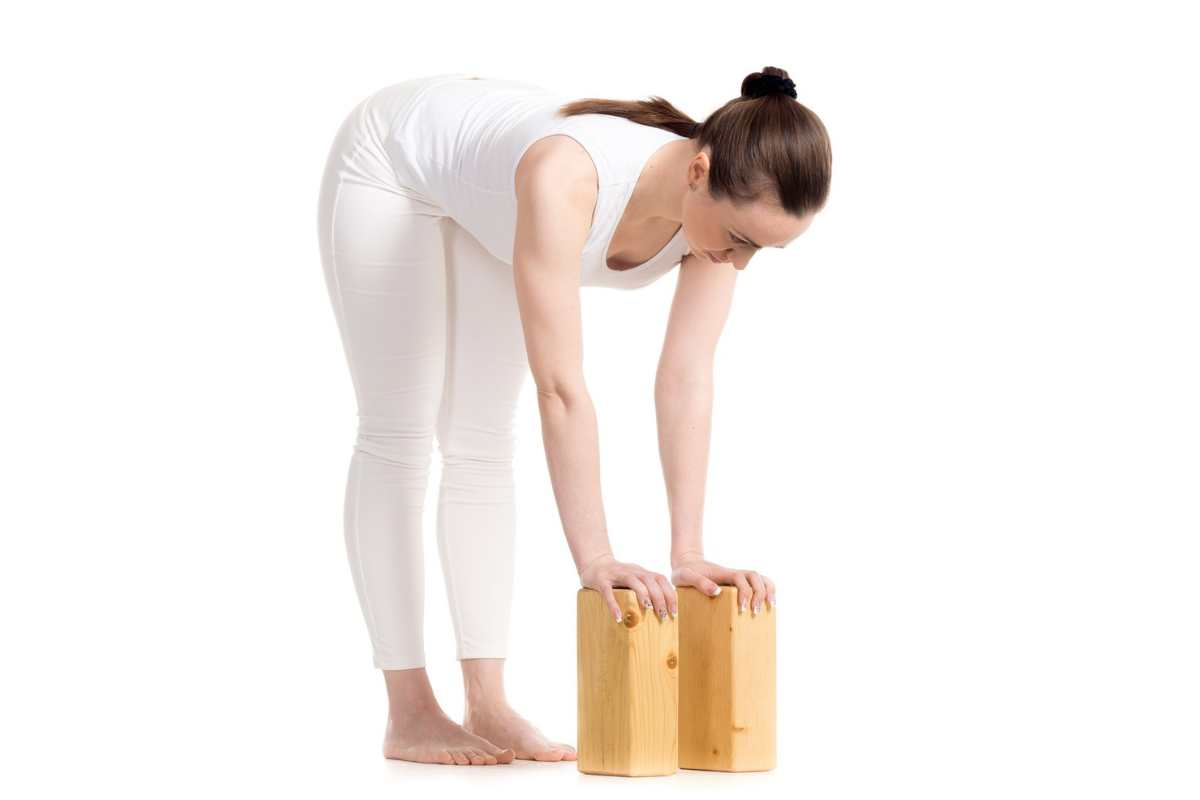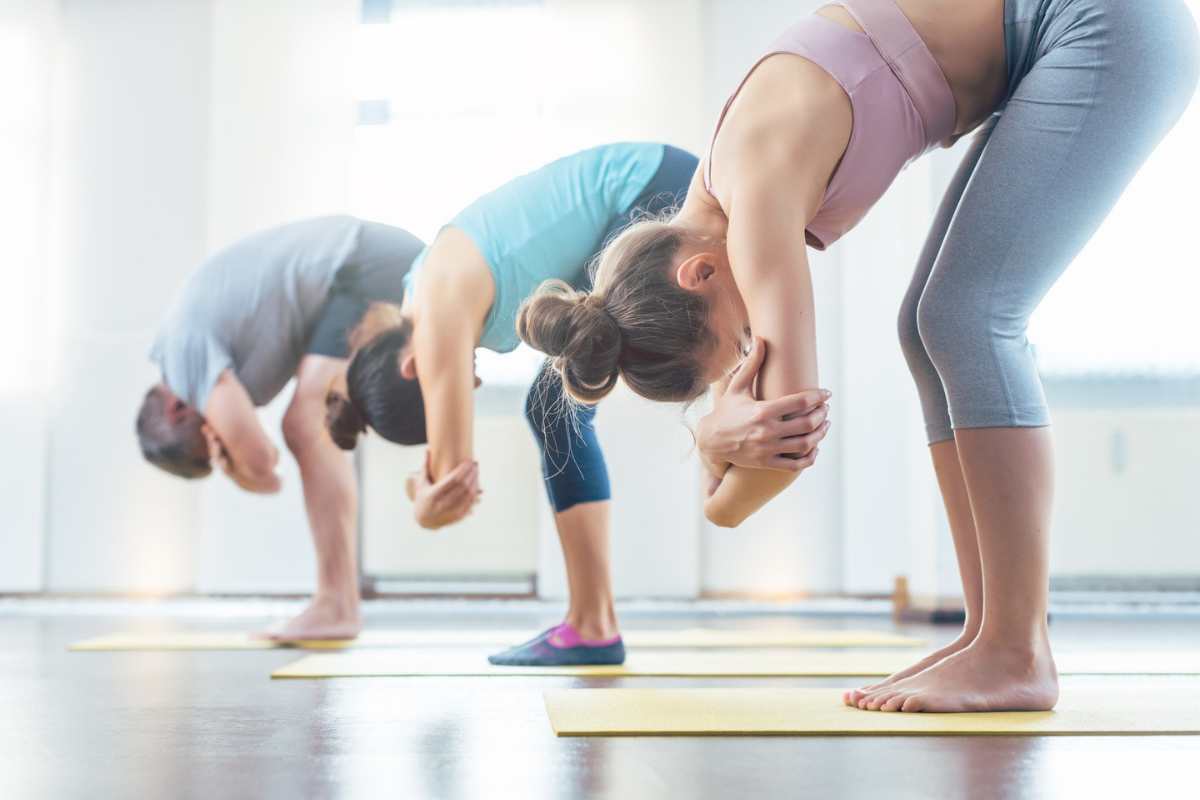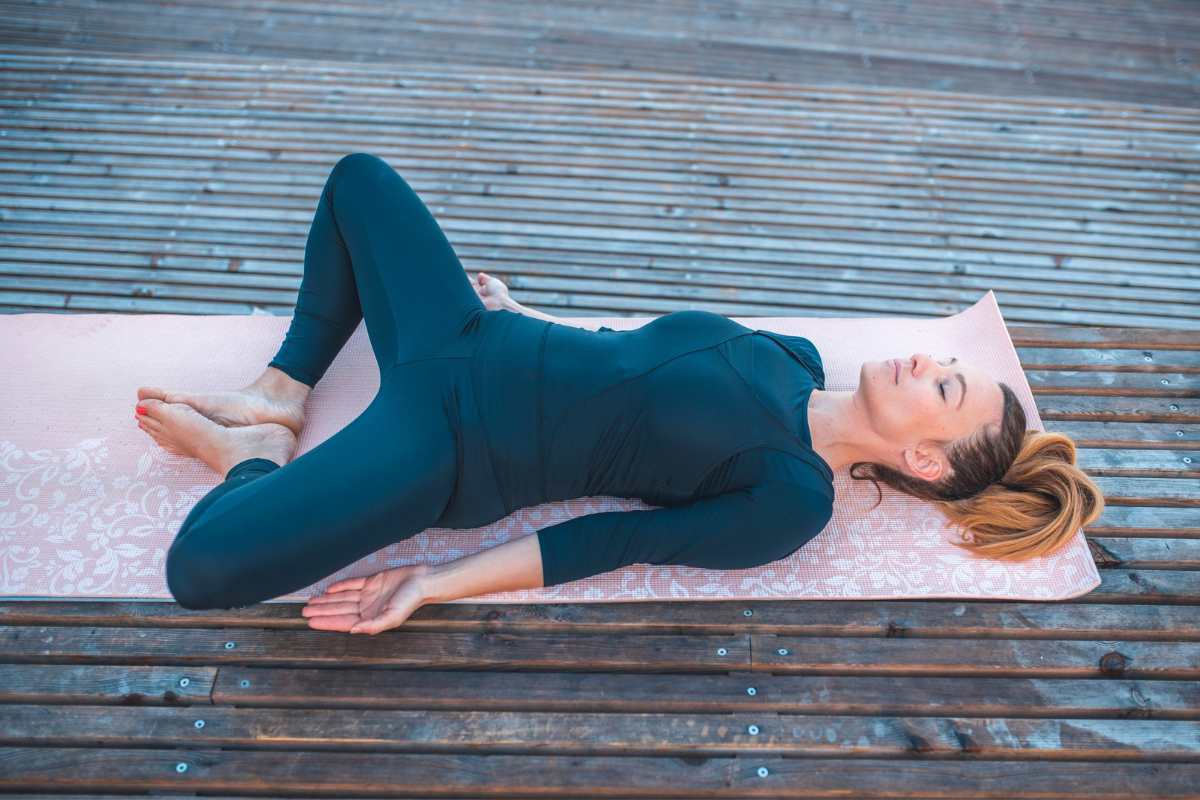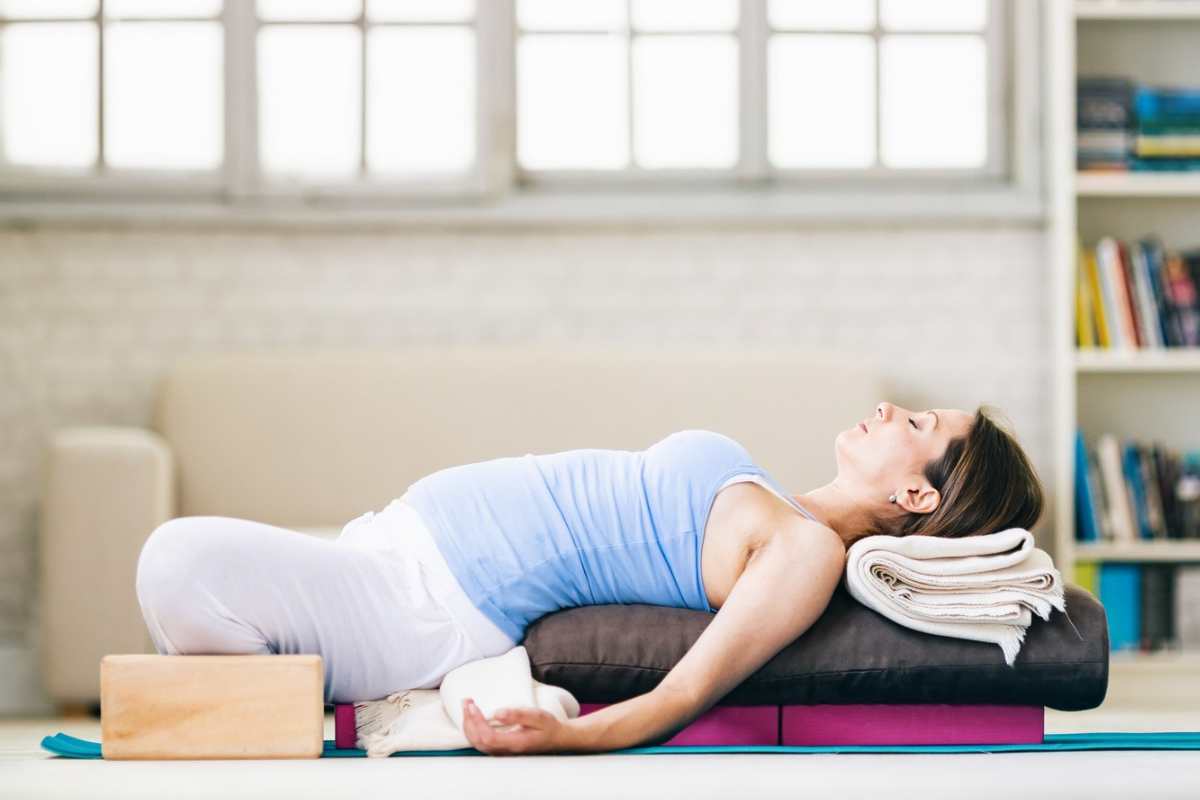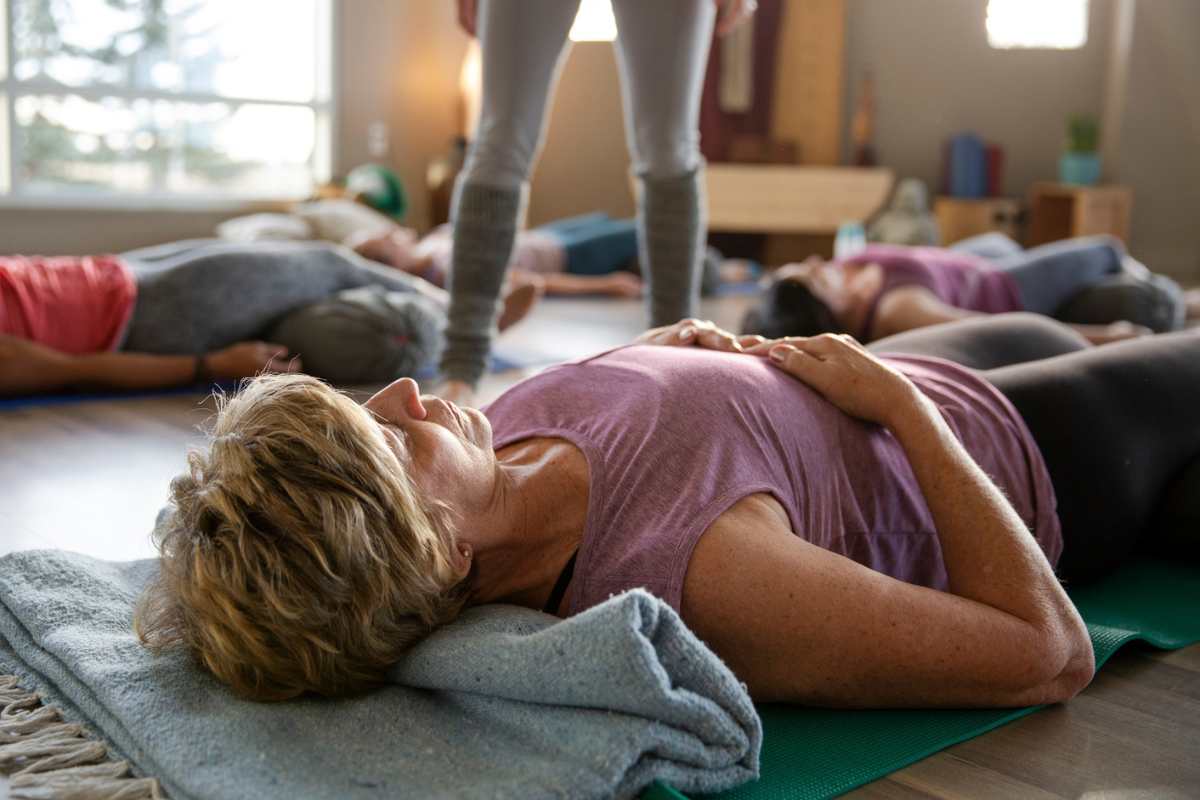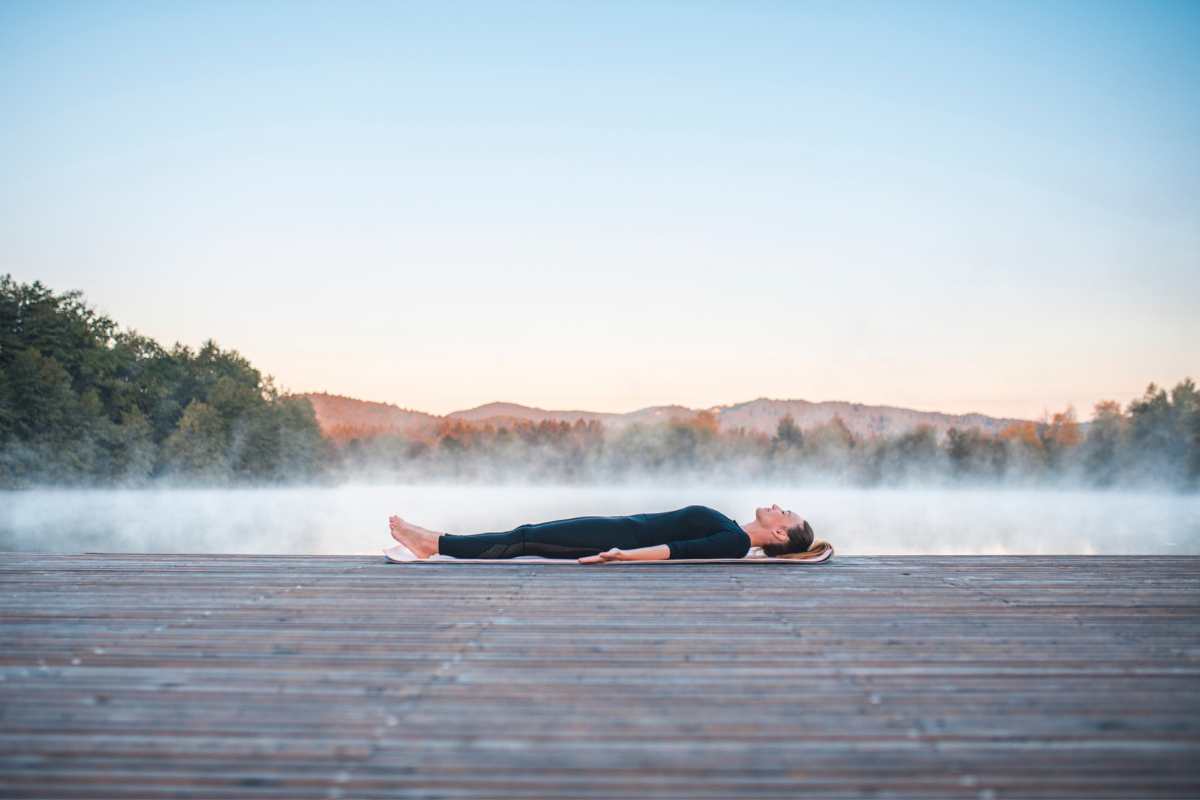During menopause, yoga can help your physical and mental well-being. This holistic practice can help you manage menopause symptoms – both emotional and physical – and get you moving. Learn yoga postures that can help with menopause symptoms and that you can do throughout your day, from your bed to your desk at work.
Yoga for menopause
The menopause journey is a natural stage in a woman’s life that can bring about a variety of physical and emotional changes. Hot flashes, mood swings, sleeplessness, and reduced bone density are just a few of the symptoms that women may experience during this time.
While hormone therapy (HT) is a common treatment option, many women seek non-hormonal approaches to manage their symptoms. One such option that has gained significant attention is the practice of yoga.
Yoga is a holistic exercise focusing on the mind, body, and spirit. The practice includes:
- asanas (physical postures)
- pranayama (breathing exercises)
- dhyana (meditation)
- shavasana (relaxation)
In recent years, researchers have turned their attention to studying the effects of yoga, specifically on menopausal symptoms. The National Center of Complementary and Integrative Health has recognized that yoga reduces and assists with managing these symptoms.
Yoga has been found to have numerous health benefits, including reducing stress, improving flexibility, and enhancing overall well-being.
Incorporating a regular yoga practice into your routine can provide numerous benefits for both your emotional and physical well-being during the menopause journey.
Embracing your body naturally through yoga
One of the beautiful aspects of yoga is its ability to help you embrace your body naturally during menopause and beyond. At pausitive health, we often talk about embracing the menopause journey. Yoga can help you do that.
A few key ways yoga promotes body acceptance are:
Body awareness
Yoga encourages you to develop a deep sense of body awareness. You become more attuned to your body through asanas and mindful movement and learn to appreciate your strengths and limitations.
Non-competitive environment
Yoga is not about comparing yourself to your past self or others striving for perfection. It is a personal practice that focuses on self-improvement and self-acceptance. In a yoga class, everyone is encouraged to honor their own bodies and practice at their own pace.
Self-care and mindfulness
Yoga teaches you to prioritize self-care and listen to your body’s needs. By practicing self-compassion and mindfulness, you can develop a healthier relationship with your body, especially when going through emotional and physical changes during the menopause journey and beyond.
Strength and flexibility
Regular yoga practice can improve strength and flexibility, allowing you to appreciate what your body is capable of. Embracing the progress and growth in your practice can foster a positive body image.
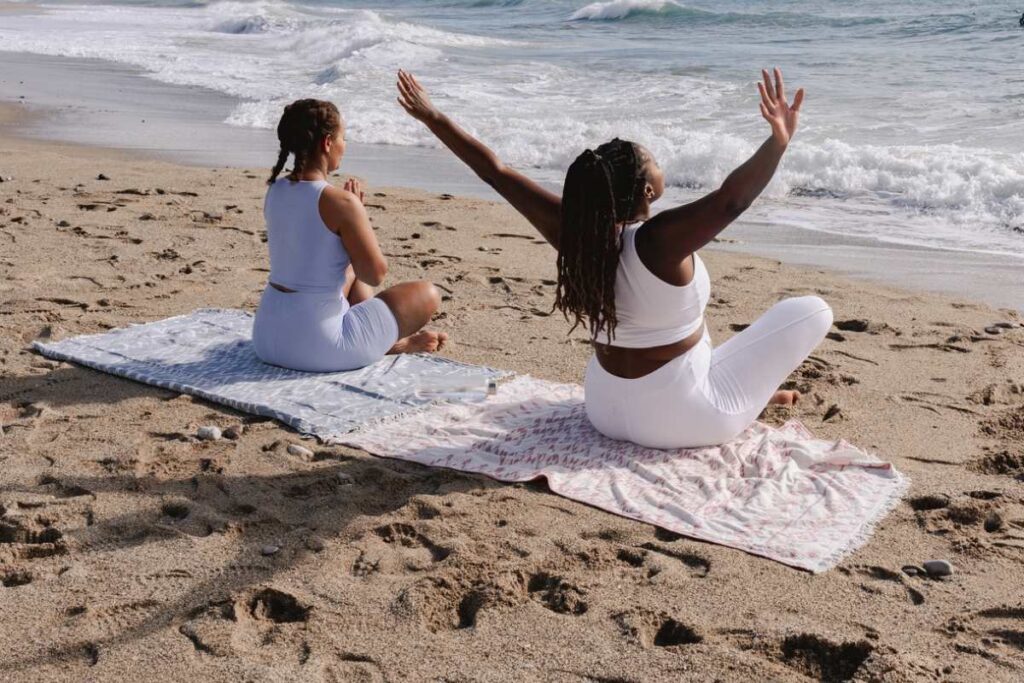
Emotional well-being of yoga
During the menopause journey, hormonal fluctuations can lead to mood swings, irritability, increased anxiety, and depression. If you’re trying to manage any of these symptoms, consider yoga.
It offers a holistic approach to emotional well-being by promoting relaxation and reducing stress.
Regular yoga practice has also been shown to help with:
- out-of-balance hormones
- feelings of anxiety
- depression, which can increase during the journey starting in perimenopause
- overall emotional well-being
- reconnecting with your body
- developing a greater sense of self-acceptance and self-love
- overall quality of life
- self-esteem
- developing a positive outlook on aging
Through yoga, you can learn to focus on your breath, quiet your mind, and cultivate a sense of inner calm.
Mindset is always critical to well-being, especially during the menopause journey. Besides using gratitude and exercise to change your mindset, give yoga a try.
As you move through different poses and become more in tune with your body, yoga helps you embrace the changes that come with the menopause journey.

Physical Benefits of Yoga
Menopause also brings physical symptoms such as hot flashes, night sweats, weight gain, joint pain, digestive unrest, and sleepless nights.
Engaging in a regular yoga practice can help alleviate these symptoms and improve overall physical well-being.
Yoga can also help with bone density and hormone production.
Hot flashes
Hot flashes, characterized by sudden waves of heat and sweating, are one of the most common symptoms experienced during the menopause journey. While you can use prescription medication, herbal remedies, remove foods from your diet, or try CBT, yoga is an additional option.
Several studies have shown that regular yoga practice can significantly reduce the frequency and severity of hot flashes. The calming and relaxing nature of yoga, combined with deep breathing techniques, helps regulate body temperature and promote a sense of calmness.
Bone density
Yoga poses, or asanas, can help increase flexibility, strengthen muscles, and improve balance. One of the significant concerns during the menopause journey, particularly during the post-menopause stage, is the loss of bone density, which can increase the risk of osteoporosis.
Weight-bearing yoga postures, such as standing poses and inversions (where your head is below your heart, like in downward-facing dog or a forward fold), can help strengthen bones and improve overall bone and muscle health.
Research has shown that regular yoga practice can increase bone density and reduce the risk of fractures.
Yoga poses strengthen weak pelvic floor muscles and help relax muscle tightness in the hips, allowing for better pelvic stability, posture, and balance. This can be particularly beneficial as the hormonal transition evolves and as you experience pelvic floor symptoms like urinary and bladder issues. Yoga is just one of the pelvic floor rehab options for treating it.

Free Physical Therapy
From the Comfort of Home
Only available for a limited time!
Become a member of the pausitive health pilot program and get physical therapist-led video exercises for the aches and pains (the musculoskeletal syndrome of menopause – MSM) that are common during the menopause journey. You can also access a program for pelvic floor issues like urinary leaking when you cough, sneeze, or laugh as well as problems with pelvic pain. The first 100 enrollees are also eligible for up to 2 live, virtual care physical therapy consultations.
You’ll also receive personalized text messages for your symptoms, a supportive community, and more!
Sleeplessness
Insomnia and sleep disturbances are common complaints among women going through the menopause journey. Research suggests that incorporating yoga into a daily routine can improve sleep quality and reduce the frequency of waking up during the night.
The combination of physical movement, relaxation techniques, and mindfulness practiced in yoga helps to calm the mind, promote better sleep, reduce fatigue, and enhance overall vitality.
Hormone production
Furthermore, yoga can help regulate the endocrine system, which is responsible for hormone production.
Certain poses, such as inversions, can stimulate the thyroid gland, which is crucial in regulating metabolism and maintaining energy levels.
The movement and yoga techniques to increase endurance can also help with weight management.
Asanas (yoga postures) to manage menopause symptoms
Asanas, or yoga postures, are an essential part of your yoga practice. They involve a series of physical poses designed to stretch and strengthen the body.
Each asana has unique benefits and focuses on different body parts. Asanas not only help improve physical fitness but also promote emotional health and mental well-being, which can be challenging during the menopause journey.
Regular practice of these postures can:
- increase body awareness
- improve concentration
- reduce stress and anxiety
- increase flexibility
- improve posture
- give a sense of overall well-being
- improve mental clarity
Remember to listen to your body and modify the poses as needed. With regular practice, you can harness the benefits of yoga and find relief from these challenging symptoms.
You can review all the poses or choose one that interests you.
Child’s Pose (Balasana)
Child’s Pose is a gentle resting pose that helps to calm the mind and relieve stress and anxiety.
- To practice this pose, start by kneeling on the floor with your knees hip-width apart.
- Sit back on your heels and lower your torso down, resting your forehead on the mat.
- Extend your arms forward or rest them alongside your body.
- Take slow, deep breaths and hold the pose for 1-3 minutes.

Legs-Up-the-Wall Pose (Viparita Karani)
Legs-Up-the-Wall Pose is a restorative pose that promotes relaxation and relieves fatigue.
- Lie on your back and place your legs up against a wall, with your buttocks close to or touching the wall.
- Keep your arms relaxed by your sides or place them on your belly.
- Close your eyes and breathe deeply, allowing your body to relax completely.
- Hold the pose for 5-10 minutes.
Cat-Cow Pose (Marjaryasana-Bitilasana)
Cat-Cow Pose is a gentle flow that helps to release tension in the spine and improve mental clarity.
- Start on your hands and knees, with your wrists directly under your shoulders and your knees hip-width apart.
- Inhale as you arch your back and lift your chest and tailbone towards the ceiling (Cow Pose).
- Exhale as you round your spine and tuck your chin towards your chest (Cat Pose).
- Repeat this flow for 5-10 breaths.
Standing Forward Bend (Uttanasana)
Standing Forward Bend is a calming inversion pose that helps to relieve stress and anxiety.
- Stand with your feet hip-width apart and fold forward from your hips, allowing your upper body to hang over your legs.
- You can bend your knees slightly if needed. Let your head and neck relax completely.
- Hold the pose for 1-3 minutes, breathing deeply and allowing your body to release tension.
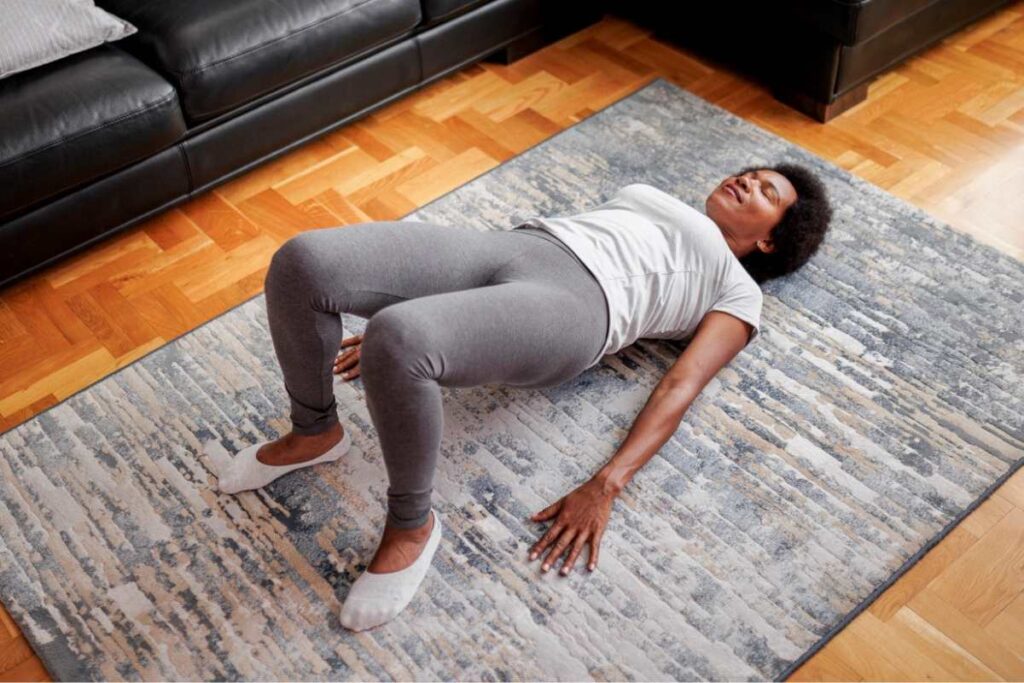
Bridge Pose (Setu Bandhasana)
Bridge Pose is a gentle backbend that helps to strengthen the lower back and abdominal muscles, alleviate sadness, and improve mood.
- Lie on your back with your knees bent and feet flat on the floor, hip-width apart.
- Press your feet into the floor and lift your hips towards the ceiling.
- Interlace your fingers under your hips and press your arms down to lift your chest higher.
- Hold the pose for 30 seconds to 1 minute, breathing deeply.
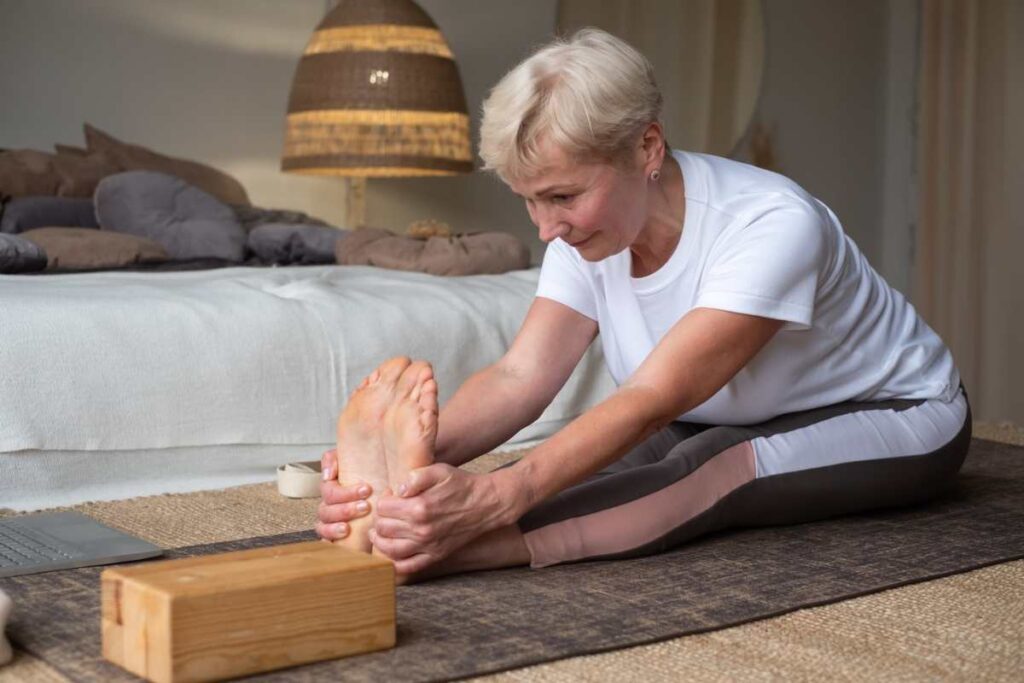
Seated Forward Bend (Paschimottanasana)
Seated Forward Bend is a calming pose that helps to relieve stress and anxiety while also improving digestion.
- Sit on the floor with your legs extended in front of you. Inhale as you lengthen your spine, then exhale as you fold forward from your hips, reaching towards your feet.
- You can use a strap or towel around your feet if needed.
- Hold the pose for 1-3 minutes, breathing deeply.
Supported Reclining Bound Angle Pose (Supta Baddha Konasana)
Supported Reclining Bound Angle Pose is a restorative pose that helps to relieve menopause symptoms such as hot flashes and mood swings.
- Lie on your back and bring the soles of your feet together, allowing your knees to fall open to the sides.
- Place a bolster or folded blanket under your knees for support.
- Rest your arms by your sides or place your hands on your belly.
- Close your eyes and breathe deeply, holding the pose for 5-10 minutes.
Corpse Pose (Savasana)
Corpse Pose is a relaxation pose that helps to calm the mind and promote deep relaxation.
- Lie on your back with your legs extended and your arms relaxed by your sides, palms facing up.
- Close your eyes and allow your body to completely relax.
- Focus on your breath and let go of any tension or stress.
- Hold the pose for 5-10 minutes or as long as you like.
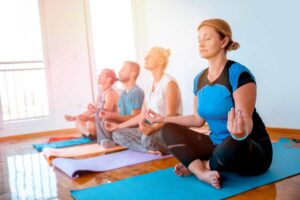 Choosing the right yoga practice for you
Choosing the right yoga practice for you
When choosing a yoga practice during the menopause journey and beyond, focus on the yoga type that suits your needs. Gentle yoga styles can be particularly beneficial, as they focus on relaxation, stretching, and breathing techniques.
Also, listen to your body and modify poses as needed. As you go through the menopause journey, your body may have different needs and limitations. Honor these changes and adapt your practice accordingly.
Like menopause, yoga is also a journey, and the benefits may not be immediate.
Consistency is key, so aim to practice yoga regularly to experience the full range of emotional and physical benefits it can offer.
Yoga classes are widely available in various settings, from yoga studios to community centers. Consider taking the first step in finding a yoga class at the following options:
Yoga studios
Dedicated yoga studios offer a wide range of classes for people of all levels. These studios have experienced instructors who can guide you through the practice.
Gyms and fitness centers
Many gyms and fitness centers offer yoga classes as part of their group exercise programs. These classes are included in the membership or available at a discounted rate.
Community centers
Local community centers host yoga classes that are open to the public. These classes are usually affordable and cater to individuals of all ages and abilities.
Online platforms
Since COVID-19, online platforms have become increasingly popular for practicing yoga. Websites and apps offer a wide range of classes that can be accessed from the comfort of your own home.
Private Lessons
Many certified yoga instructors also do private lessons at a location convenient for you – at your home, work site, or a nearby park.
When choosing a yoga class, consider your level of experience, preferences, and any specific goals you may have. It is important to find a class and instructor who aligns with your needs and values.

Yoga throughout the day
While many people think of yoga as a separate activity to be done in a dedicated space, it can be seamlessly integrated into your daily life.
Incorporating yoga into your activities of daily living allows you to experience the transformative power of yoga, offering numerous physical, mental, and emotional benefits throughout your day.
Practicing yoga at different points in the day provides various benefits.
Mornings
Many people prefer to start their day with a yoga practice. Morning yoga can help energize the body and prepare the mind for the day ahead.
Evenings
Some individuals find that practicing yoga in the evening helps them unwind and relax after a busy day. Evening yoga can promote better sleep and relieve tension.
Anytime
Yoga can be practiced at any time that suits your schedule. Whether during your lunch break or before bedtime, finding a consistent time that works for you is key.
Remember to listen to your body and choose a time when you are most comfortable and focused.
Consistency is key in reaping the benefits of a regular yoga practice. Yoga is a journey of self-discovery and self-acceptance. It provides a safe and nurturing space to connect with your body and cultivate a positive body image.
Here are some ways to do yoga throughout your day, including:
- at your desk
- during lunchtime
- in a quiet space
- in your bed
Desk Yoga
Incorporating desk yoga into your routine can be highly beneficial for those who spend long hours working at a desk. Desk yoga involves simple stretches and movements that can be done right at your workspace. These exercises help to release tension, improve posture, and increase energy.
Try these simple desk yoga poses:
Neck Rolls
Gently roll your neck clockwise and counterclockwise to release tension in the neck and shoulders.
Seated Forward Fold
Sit tall in your chair and fold forward from the hips, reaching your hands towards your feet. This pose stretches the hamstrings and releases tension in the lower back.
Wrist Stretches
Extend your arms in front of you and gently rotate your wrists in circles to relieve stiffness and improve flexibility.
Lunchtime Yoga
Instead of spending your lunch break scrolling through social media or eating at your desk, consider using that time to practice yoga.
Lunchtime yoga is a great way to recharge and rejuvenate during the day.
You can either find a nearby yoga studio that offers lunchtime classes or practice yoga on your own.
If you choose to practice independently, find a quiet and comfortable space to roll out your mat and dedicate some time to yourself. Incorporating lunchtime yoga into your routine can reduce stress, increase focus, and improve your overall well-being.
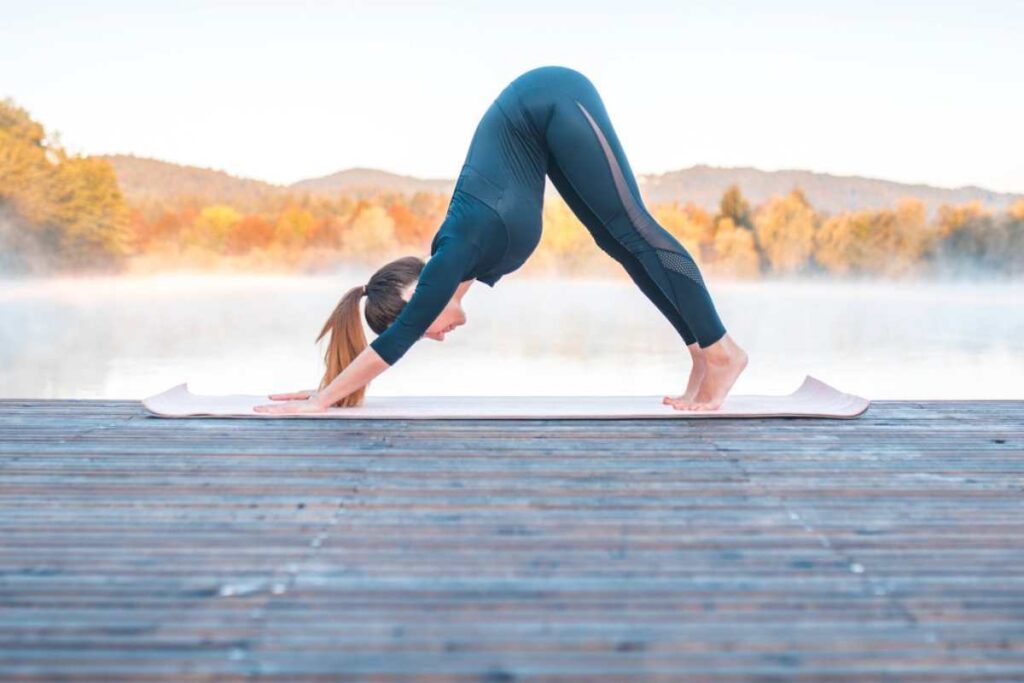
Here are some lunchtime yoga poses you can do:
Child’s Pose
Kneel on the floor and sit back on your heels, lowering your forehead to the ground. This pose helps to release tension in the back and shoulders.Downward-Facing Dog
Start on your hands and knees, then lift your hips up and back, forming an inverted V shape with your body. This pose stretches the entire body and increases circulation.
Warrior II
Stand with your feet wide apart, turn your right foot out, and bend your right knee. Extend your arms out to the sides, keeping them parallel to the ground. This pose strengthens the legs and improves balance.
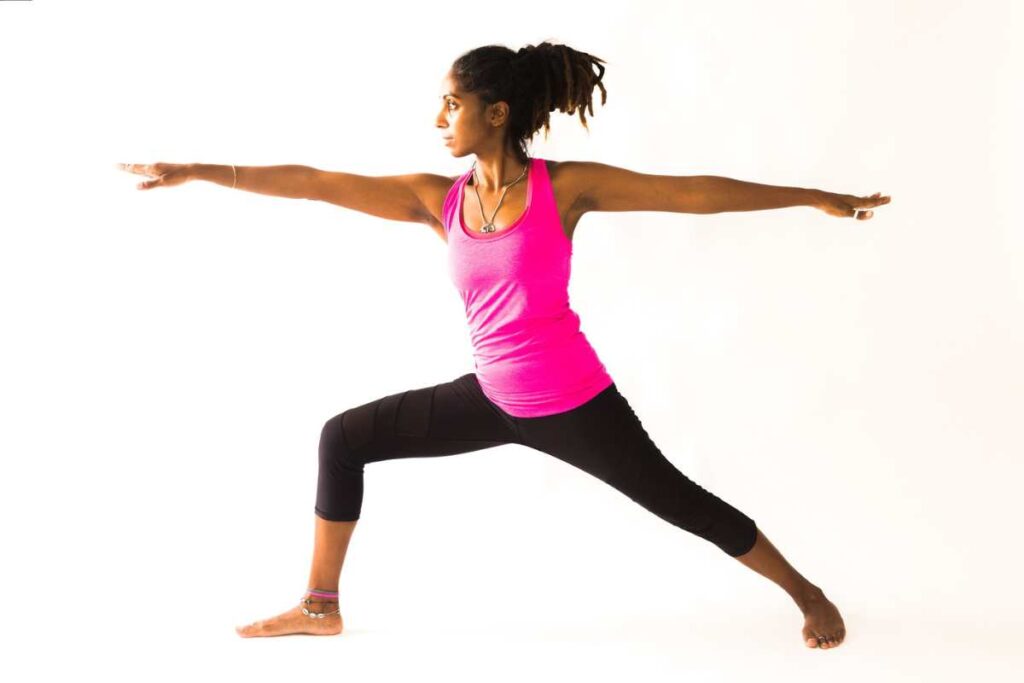
Quiet Spaces
In our fast-paced world, finding moments of peace and quiet can be challenging. Creating quiet spaces in your home where you can practice yoga and meditation can help you find balance and tranquility amidst the chaos.
Designate a corner of a room, a small area where you can create your personal sanctuary, or outside near a beach or garden.
Add elements that promote relaxation, such as candles, cushions, soft lighting, and sounds like sea waves.
This space can be used for yoga practice, meditation, or simply to take a few moments to breathe and center yourself. By having a designated quiet space, you can easily incorporate yoga into your daily life and cultivate a sense of calm and well-being.
Morning or Evening in Bed
Starting or ending your day with a gentle yoga practice in bed can be a wonderful way to set a positive tone for the day or promote restful sleep at night. These gentle stretches can be done right in the comfort of your bed, making it easy to incorporate into your daily routine. You can start or end your day with a sense of peace and well-being.
Here are a few yoga poses you can try in bed:
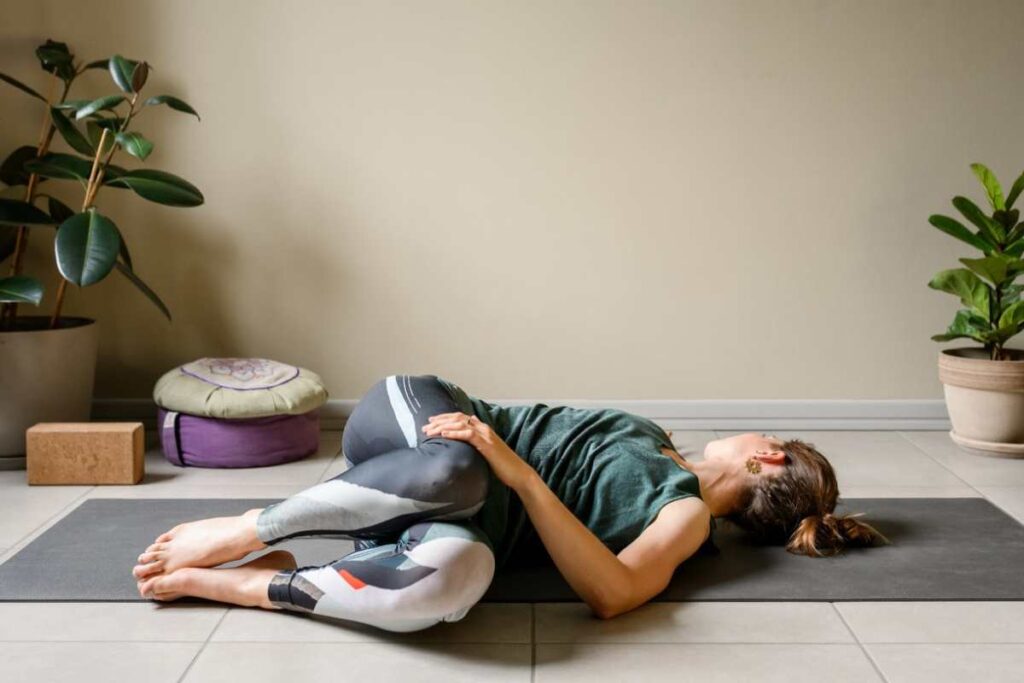
Supine Spinal Twist
Lie on your back and bring your knees to your chest. Extend your arms out to the sides, then slowly lower your knees to one side while keeping your shoulders grounded. This pose releases tension in the back and promotes spinal mobility.
Corpse Pose
Lie flat on your back with your arms by your sides and palms facing up. Close your eyes and focus on your breath. This pose promotes deep relaxation and can help prepare your mind and body for sleep.
Legs Up the Wall
Lie on your back and extend your legs up against the wall. This pose helps to reduce swelling in the legs, calm the nervous system, and promote relaxation.
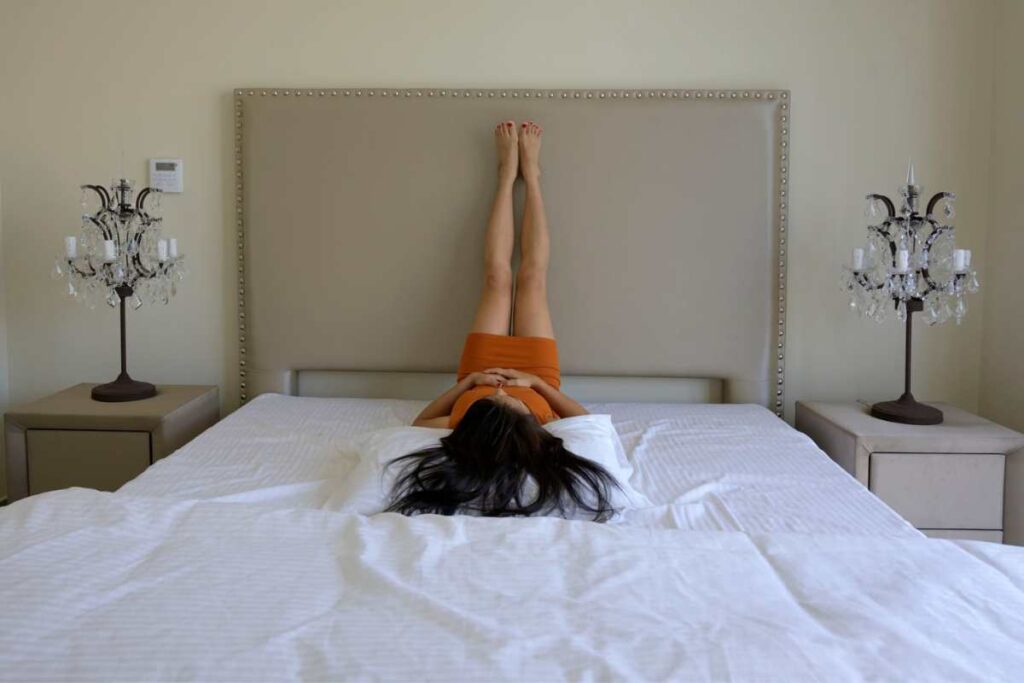
Education and Workshops
If you are looking to deepen your understanding of yoga and its benefits, consider attending yoga education programs or workshops. These programs provide an opportunity to learn from experienced instructors and explore different aspects of yoga.
Yoga education programs and workshops cover a wide range of topics, including yoga philosophy, anatomy, meditation techniques, and advanced asana practice. By immersing yourself in these learning experiences, you can gain valuable knowledge and skills to incorporate into your daily life.
Many yoga studios and wellness centers offer regular workshops and events, so keep an eye out for opportunities in your area.
These workshops may also be held by your employer. At Asana with Fatima, we work with employers to bring yoga and mindfulness sessions to the workplace.
Make a change for the better with yoga
Incorporating a regular yoga practice into your routine during the menopause journey and beyond can profoundly impact your emotional and physical well-being. By promoting relaxation, reducing stress, improving flexibility, and enhancing overall vitality, yoga can help you navigate through these transitions with grace and resilience.
From reducing hot flashes and improving sleep quality to alleviating mood swings and strengthening bones, yoga offers a natural and holistic approach to managing these transitional stages in your life.
By embracing the practice of yoga, you can enhance your overall well-being and navigate this phase with greater ease and grace.
Whether it’s practicing in a studio or online, at your desk at work, dedicating your lunch break to yoga, creating quiet spaces, practicing yoga in bed, or attending educational workshops, there are numerous ways to integrate yoga into your daily routine.

Fatima Karim-Murji
Fatima is a Canadian-trained Registered Nurse of 26 years, with a Bachelor of Science in Nursing and a Master of Science specializing in Health Sciences. Her clinical background in medical surgical nursing, maternity, neurology, population health management, healthcare benefits and management, along with engagement strategies for corporations, has taught her a lot about wellness and sustaining a healthy lifestyle. She is certified with the Wellness Council of America (WELCOA) and has extensive training in Mental Health First Aid for Adults and Youth. She is a Registered Yoga Teacher and Mindfulness Guide (RYT 200hrs).
For the past five years, she’s focused her energy on yoga and mindfulness, teaching students in person 1-on-1, virtually during COVID-19, at corporate wellness events, and in the studio. Her passion is working with people from all walks of life to maintain a healthy work- life balance through their health journey. Whether it be in an office environment, at your desk, in a classroom, at the studio, or virtually, yoga and mindfulness can be done anywhere, anytime. Fatima lives in Dallas, Texas where she enjoys teaching and practicing Yoga, spending time with family and friends, and seeing all that the world has to offer. Sign up for our monthly newsletter and get updates on what’s new at AsanawithFatima.com.
Cramer H, Peng W, Lauche R. Yoga for menopausal symptoms – A systematic review and meta-analysis. Maturitas. 2018 Mar;109:13-25. doi: 10.1016/j.maturitas.2017.12.005. Epub 2017 Dec 6. PMID: 29452777.
Menopausal Symptoms and Complementary Health Approaches: What the Science Says | National Center for Complementary and Integrative Health
Yoga: What You Need To Know | National Center for Complementary and Integrative Health
Cramer H, Lauche R, Langhorst J, Dobos G. Effectiveness of yoga for menopausal symptoms: a systematic review and meta-analysis of randomized controlled trials. Evid Based Complement Alternat Med. 2012;2012:863905. doi: 10.1155/2012/863905. Epub 2012 Nov 7. PMID: 23304220; PMCID: PMC3524799.
Susanti HD, Sonko I, Chang PC, Chuang YH, Chung MH. Effects of yoga on menopausal symptoms and sleep quality across menopause statuses: A randomized controlled trial. Nurs Health Sci. 2022 Jun;24(2):368-379. doi: 10.1111/nhs.12931. Epub 2022 Mar 21. PMID: 35191141.
The Women’s Health Big Book of Yoga | Katheryn Budig (2012).
Yoga and Sleep | Sleep Foundation
Menopausing: The positive roadmap to your second spring | Davina McCall with Dr. Naomi Potter (2022).
Questions to ask your Doctor (PDF) | Navigating Your Healthcare Journey
Mayo Clinic The Menopause Solution | Faubion, S., M.D.
Making Friends with the Menopause 2018 ed. | Raynor, S. & Fitzgerald, P.
Menopause | Mayo Clinic
Menopause (StatPearls)
Barbieri R. Patient Education: Menopausal Hormone Therapy (Beyond the Basics). UpToDate. 2023.
Loprinzi C. Non-estrogen Treatments for Menopausal Symptoms. Literature review Jan. 2024. UpToDate.
Menopausal Symptoms: In Depth | NCCIH
(VIDEO) Life’s Lessons on Menopause (Krames Staywell)
Menopause resources | Medline Plus
Rees M, Bitzer J, Cano A, Ceausu I, Chedraui P, Durmusoglu F, Erkkola R, Geukes M, Godfrey A, Goulis DG, Griffiths A, Hardy C, Hickey M, Hirschberg AL, Hunter M, Kiesel L, Jack G, Lopes P, Mishra G, Oosterhof H, Pines A, Riach K, Shufelt C, van Trotsenburg M, Weiss R, Lambrinoudaki I. Global consensus recommendations on menopause in the workplace: A European Menopause and Andropause Society (EMAS) position statement. Maturitas. 2021 Sep;151:55-62. doi: 10.1016/j.maturitas.2021.06.006. Epub 2021 Jul 21. PMID: 34274202.
Hardy, C. Menopause and the workplace guidance (2020): Editorial/fact sheet, UK focused.
Sarrel P, Portman D, Lefebvre P, Lafeuille MH, Grittner AM, Fortier J, Gravel J, Duh MS, Aupperle PM. Incremental direct and indirect costs of untreated vasomotor symptoms. Menopause. 2015 Mar;22(3):260-6. doi: 10.1097/GME.0000000000000320. PMID: 25714236.
Kagan R, Shiozawa A, Epstein AJ, Espinosa R. Impact of sleep disturbances on employment and work productivity among midlife women in the US SWAN database: a brief report. Menopause. 2021 Aug 30;28(10):1176-1180. doi: 10.1097/GME.0000000000001834. PMID: 34469936; PMCID: PMC8462448.
Smith KB, Pukall CF. An evidence-based review of yoga as a complementary intervention for patients with cancer. Psychooncology. 2009 May;18(5):465-75. doi: 10.1002/pon.1411. PMID: 18821529.
Innes KE, Selfe TK. Yoga for Adults with Type 2 Diabetes: A Systematic Review of Controlled Trials. J Diabetes Res. 2016;2016:6979370. doi: 10.1155/2016/6979370. Epub 2015 Dec 14. PMID: 26788520; PMCID: PMC4691612.
What Are the Benefits of Yoga for Osteoporosis? | Verywell Health
Lu YH, Rosner B, Chang G, Fishman LM. Twelve-Minute Daily Yoga Regimen Reverses Osteoporotic Bone Loss. Top Geriatr Rehabil. 2016 Apr;32(2):81-87. doi: 10.1097/TGR.0000000000000085. Epub 2015 Nov 5. PMID: 27226695; PMCID: PMC4851231.
Cramer H, Lauche R, Langhorst J, Dobos G. Yoga for depression: a systematic review and meta-analysis. Depress Anxiety. 2013 Nov;30(11):1068-83. doi: 10.1002/da.22166. Epub 2013 Aug 6. PMID: 23922209.
You may also like…
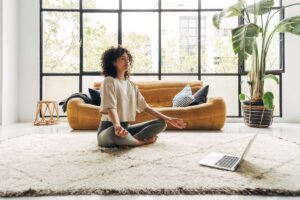
Power Through Menopausal Changes with this RAIN Mindfulness Technique
The RAIN mindfulness technique can help you power through menopausal changes with a positive mindset. Read or listen to this script.

Missing Your Life Before Menopause? How to Manage The Grief and Loss
Do you ever think about life before menopausal symptoms? If you feel a sense of loss or grief, try these emotional coping strategies.

How Stress Affects Your Body and Makes Menopause Symptoms Worse
Did you know stress symptoms and menopausal symptoms are similiar?Learn how stress affects your body and how it can mkae menopause symptoms worse.


